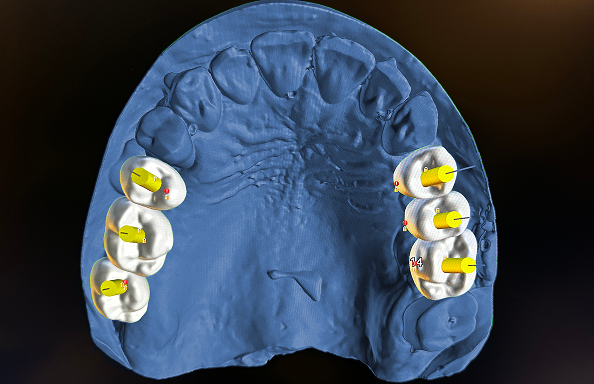Dental implant procedures have evolved significantly with the introduction of advanced digital technologies. One of the most revolutionary tools in modern implantology is the implant surgical guide — a custom-made device that helps dentists perform implant placements with unmatched precision and safety.
An implant surgical guide ensures accurate positioning, optimal angulation, and the ideal depth for dental implants, leading to better functionality, aesthetics, and long-term results.
🔍 What Is an Implant Surgical Guide?
An implant surgical guide is a 3D-printed or milled template that assists dental professionals in accurately placing implants according to a pre-planned digital model. It’s designed based on a patient’s CBCT scan and digital impressions, allowing the dentist to visualize bone structure, nerve locations, and soft tissue before the procedure.
This guide acts as a physical roadmap during surgery, ensuring that every implant is placed at the right angle, depth, and location as digitally planned.
🧩 How Does It Work?
Creating an implant surgical guide involves a combination of digital imaging, software planning, and 3D printing technology. Here’s a breakdown of the process:
- Data Collection – The process starts with taking a cone beam CT (CBCT) scan and digital impressions of the patient’s mouth.
- Treatment Planning – Using specialized software, the dentist creates a detailed 3D model of the jaw and plans the precise implant positions.
- Guide Fabrication – A custom surgical guide is designed and 3D-printed to match the patient’s unique oral anatomy.
- Implant Placement – During surgery, the guide is positioned in the mouth, and implants are placed through the guide holes, ensuring precision and minimal deviation.
This step-by-step digital workflow minimizes errors and improves overall surgical predictability.
⚙️ Types of Implant Surgical Guides
Different types of guides are available depending on the surgical approach and the number of implants:
- Tooth-supported guide: Rests on the remaining natural teeth; ideal for partially edentulous cases.
- Mucosa-supported guide: Sits on the gum tissue; used for fully edentulous patients.
- Bone-supported guide: Placed directly on the jawbone; suitable when teeth or soft tissue are absent.
Each guide type is selected based on clinical conditions and the complexity of the case.
💡 Benefits of Using an Implant Surgical Guide
Using an implant surgical guide enhances both accuracy and predictability in implant dentistry. Here are the key benefits:
1. Improved Accuracy
The guide ensures precise alignment and positioning, reducing the risk of nerve damage or implant failure.
2. Minimally Invasive Surgery
Since the guide dictates exact drilling locations, flapless or smaller incisions can be made — leading to less bleeding, swelling, and pain post-surgery.
3. Reduced Chair Time
The pre-planned digital workflow shortens surgical time and simplifies the procedure for both the dentist and the patient.
4. Enhanced Aesthetics
Implants placed in ideal positions support natural-looking crowns, bridges, or dentures, improving overall facial harmony.
5. Predictable Outcomes
Every implant position is digitally verified before surgery, resulting in consistent, repeatable, and reliable results.
🦾 Applications in Modern Implant Dentistry
Implant surgical guides are used in a variety of clinical scenarios:
- Single-tooth implants – For precise replacement of a missing tooth.
- Multiple implants – Ensures even spacing and proper angulation.
- Full-arch restorations – Allows for guided placement of several implants in complex rehabilitations.
- Immediate implants – Helps in quick and accurate placement right after tooth extraction.
With digital precision, even complex cases can be managed with confidence and efficiency.
🧠 The Role of Technology in Surgical Guides
The combination of CAD/CAM software and 3D printing has revolutionized the creation of surgical guides. Digital planning allows for a “virtual surgery” before the actual procedure, enabling the dentist to identify potential issues early and make corrections in the plan.
Additionally, AI-powered design tools now help optimize implant positioning based on bone density and prosthetic outcomes — taking precision dentistry to the next level.
👨⚕️ Why Dentists Prefer Guided Implant Surgery
Dentists and oral surgeons prefer using implant surgical guides because they provide:
- Greater control and accuracy
- Reduced risk of complications
- More predictable implant success rates
- Shorter recovery times for patients
This approach enhances both patient experience and clinical confidence, ensuring long-term implant success.
🏁 Conclusion
An implant surgical guide is more than just a tool — it’s a bridge between digital planning and clinical precision. By integrating advanced imaging, design, and 3D printing technologies, it allows dentists to deliver safe, efficient, and predictable implant treatments.For patients, this means faster recovery, minimal discomfort, and a long-lasting smile. Guided implant surgery truly represents the future of precision dentistry — where innovation meets reliability.





Comments